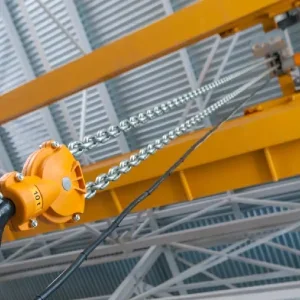Maintenance season is now well underway on the UK’s Worcester and Birmingham canal. Every winter, when the leisure boaters that fill the canals all summer long have headed indoors, the local British Waterways team is replacing anything from five to 12 sets of lock gates. Similar teams are at work at canals throughout the country.
The gates are built to match the originals, and can withstand water forces of 20t. The gates generally weigh about 2t, 2.2t if waterlogged, says British Waterways team supervisor John Williamson.
“Lifting is a small part of the job. But it’s vital – if you can’t lift the gates, you can’t change them,” he says. “On occasion we slacken off the collars and use jacks to raise the gates six inches, but this tends to be for refitting or adjustment than new works.”
The biggest problem is getting the crane to the lock in the first place. “Access is a big problem: we get it to the site by boat or down a path,” Williamson said. “We’re taking it on rough terrain compared with what it was designed for.”
The team has used truck or crawler cranes. “We use normal road cranes where we can,” he says, but adds that building a road to the lock increases the costs and time of the job. Cranes can sometimes be transported on the canal, but the cranes still need to be loaded and unloaded from the barge, and costs mount.
“Only last year we were replacing a 5.5t gate, and had to use a 20t capacity crawler. There was no other way of doing it.” Still, he quoted weekly hire costs for the crawler at £1,000 ($1,750), a major fraction of the cost of a gantry on its own. He says that they have used mini-crawler cranes before but says they are not suitable for his canals.
Gangers – canal workers – used to hoist the lock gates into place with manual chain blocks attached to sheerlegs – timber triangles equipped with a spike for a base. “If you were to push it into positions out of plumb, there were a lot of accidents.”
They replaced these with steel gantries that span the width of the lock. Although more stable, these added new problems. “So much of the area we can’t get to. We have to work from the boat on the bottom of the lock, or from the top. Wherever we put the gantry, there is a gap of at least 8-9ft we can’t be in.” But Williamson adds that the team cannot board over the area because it needs access to the space for maintaining sills and other elements in the drained lock bed.
The gate lifting process is simple. Normally, the team floats a boat to the gate, lifts up the old gate, and touches the bottom of the gate on the boat. Then they move the boat forward as the gate drops on to the boat. The gantry is locked in position during the lift. The process is reversed for installing a gate.
The team uses an old Ingersoll-Rand chain hoist, originally designed for mine work, that lifts 3t on a single fall of chain. ‘It enables us to lower into the lock chamber 1t excavators, muck skips and all sorts besides the gate work,’ he said. Electric power on site is limited to a portable generator. To operate the electric hoist, the team switches off the pumps draining the lock bed, hoist the load for about a minute, and then turn the pumps back on.
Up until a few years ago, the teams were using a steel frame with an 18ft (5.5m) span and 20ft (6.1m) lift. But this unit weighs about a tonne. The gantry was often transported by hand, and was so heavy that workers injured their backs, Williamson said.
The workers have now switched to a 220kg aluminium alloy gantry made by UK firm Reid Lifting. The company claims the gantry, which comes apart into three pieces, the heaviest 80kg, can be carried to the job site by three people. Then the components are pinned together and jacked up with a ratchet strap. The new 3t-capacity gantry’s dimensions – 17ft span and 18ft lift – are slightly smaller than the older gantry.
Its behaviour is different as well. ‘It is working at the top end of the aluminium,’ Williamson says. ‘There is a hell of a deflection on it. It bends by about four inches, which looks really unnatural. It has a test certificate, and they say that it’s okay for it to bend.’
Still, Williamson calls it ‘a good bit of kit’ and nearly and says that the gantry is 99% there. Although his group is only buying one or two, he said he thought that the potential volume for a canal design may be up to 50 units.
One particular modification is the trolley. The hoist hangs from a trolley that is attached by rope to pulleys mounted on end-plates. Originally the trolley ran on a geared system with a chain, which Williamson said was too heavy. He said he has been working with the manufacturer to perfect a roll-pulley system. ‘We pull at funny angles,’ he said. Estimated price for this model is about £4,000 ($7,600), down to £2,000 ($3,800) for a 500kg-capacity model.






